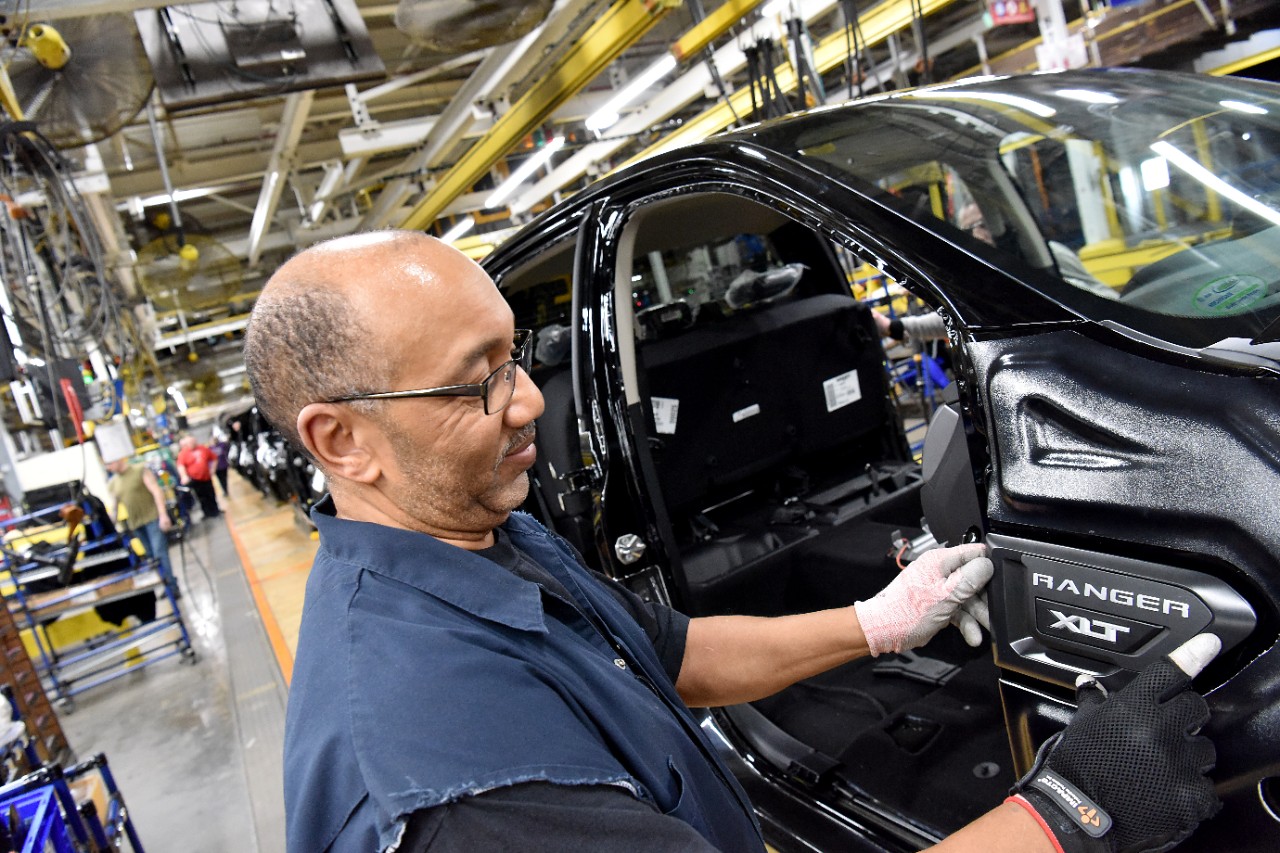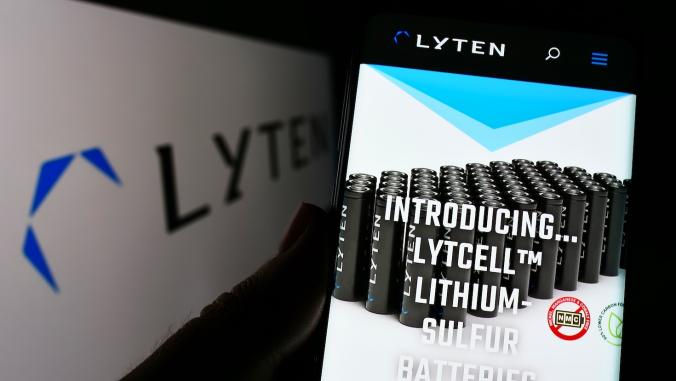A conversation with Ford's sustainability leader
How will the No. 2 American automaker focus on sustainability amidst restructuring and major transformation?

About three months ago, Bob Holycross was promoted to become Ford's top environmental and safety officer, charged with implementing the automaker's sustainability practices, among other things. Even though Ford is facing both internal restructuring and as well as the massive transformation happening in the broader automotive industry, the company continues to make strong commitments to sustainability.
Ford pledges to use 100 percent renewable energy for all of its manufacturing plants (by 2035), eliminate single-use plastics from its operations (by 2030) and achieve zero waste to landfill across its operations. But of course the biggest impact Ford can have on fighting climate change is transforming its vehicles from gas-powered trucks — its Ford F-150 is the bestselling truck in America — to electric and lower-emissions vehicles as well as offering more mobility services.
Last month, GreenBiz chatted with Holycross to get his take on what the second-largest U.S. automaker — and fifth largest in the world — plans to do around sustainability in 2020 and how internal and external disruption is helping or hurting. This interview has been lightly edited for clarity and length.
Katie Fehrenbacher: What are your plans for Ford and sustainability in 2020?
Bob Holycross: We are starting to get knee-deep in the transformation of our product portfolio, in particular around electrification and some of the new technologies that are going to enable even greater benefits to the environment. As vehicles get smarter and we start to leverage some of those opportunities beyond just zero emissions out of the tailpipe, we were able to take a step back, recognizing who we’ve been as a company for the last 115 years, what our legacy is, and start to really think about what we want to be in the future.
Beyond just the time cycles of our business plans, but who we really truly aspire to be. And we set out some pretty ambitious goals for CO2 and marching towards a zero-emissions future. And really honoring our commitment we’ve made, and were one of the first to make quite frankly, around the Paris Climate Accord and how we’ve operationalized that and the opportunities are to continue on that journey into the future.

We also took a look at other aspects of our business for how we want to run our facilities and manufacture products and have aspirations for using only 100 percent renewable energy by 2035. We look beyond energy, air emissions and CO2 but also take a look at water usage and a lot of the issues we know around water scarcity and preserving clean drinking water for human consumption as opposed to any unnecessary use in manufacturing for our operations. And setting goals to become true zero waste to any landfill globally as well. And other things like eliminating single-use plastics by 2030.
We have our sustainability report and some of the details are all in that, but for me, the opportunity that we had last year in marking our 20th anniversary [of sustainability reporting] was actually galvanizing these aspirational goals and focusing on how do we execute? Instead of debating about the strategy, how do we execute? The best way for us to do that is to continue to leverage the great people we have around the world in our different operations who are so very passionate about this even on their own accord.
Fehrenbacher: With so many things on the roadmap, what are the sustainability priorities for 2020?
Holycross: For 2020, we have — just like we did last year — some significant product launches. Obviously we're very excited about the launch of the Mustang Mach E all-electric SUV and the page that really turns in our strategy around electrification. So the work being done beyond just the unveiling toward the end of last year. It’s now really rolling up our sleeves and getting the product out later this year. That’s a priority for us.
And we have other product launches that are coming as well. We’re transforming our F-150 pickup yet again, and we’re going to have a hybrid version of that coming out and have announced our plans to have a fully electrified F-150. We have a number of new hybrid electric vehicles and plug-in hybrid electric vehicles that have launched over the last couple of months, and we continue to launch this year — like the Escape in the U.S. and other vehicles throughout the world with our partners. So that’s our big focus on the product side.

On the manufacturing side, it is continuing to make sure through our governance processes that we have in our facilities that we’re not missing any opportunities to pull ahead any of our ambitions in terms of our waste management reductions. One of the things that's able to happen is we can convert our manufacturing plant to build all these new exciting products, especially electrified products, and it really starts to change the footprint within the facilities of how the work is structured and the material flows through the plants. We’re focused on implementing a lot of opportunities to continue to reduce our waste and expand the use of renewable energy that powers the plants with it.
This year is a big year. The types of things I’m talking about are front and center each year, but I would say the biggest focus is on our product transformation to the market in the 2022 timeframe. This is all where it starts to really take root: this year.
Fehrenbacher: How is Ford tackling adding more sustainable materials to its vehicles?
Holycross: It’s part of the overall broader sustainability portfolio. The interesting thing is this is not something that’s new for us. There’s been a lot of innovations over the last several years to get more plant-based, renewable-type of materials into our products.
Right now, we have plant-based materials in over 20 million vehicles across the world. Recycled materials — in other words, using materials that have been used previously — are up to about 20 percent of our vehicles. We’ve gotten recognition in the past for using tree-based cellulose hybrid materials to reduce waste.
One of the exciting things, in particular, this year is some work on coffee chaff from coffee beans in the headlamp casings for our vehicles. And we let a lot of that continue to drive up through the organizations organically, through our research scientists and product development engineers; they’re always looking for opportunities to reduce waste or get more efficient in terms of cost.
The ideas that come through this base holistically are what we’re most proud of. So that’s a journey that we're going to continue to do as we march toward our goal in the 2030 timeframe.

Fehrenbacher: Is Ford focused on the circular economy? Is that a term that you and the company use internally or externally?
Holycross: Yes. We’ve had discussions with a number of our external stakeholders and that has been something we’re trying to look at. It’s one thing to use renewable materials in our products. It’s one thing to reduce the overall waste of the materials that we use. But more importantly, what happens after the vehicle is done? How do we even look at new business opportunities to use things like batteries after their vehicle life is over and stationary source applications? What are some of the other opportunities to take it all the way down to a zero-type of footprint solution? So it's definitely something we’re engaging in and learning more about as well.
Fehrenbacher: In terms of the second life battery ecosystem, it’s early days, but has Ford made any inroads in that area?
Holycross: It is something we’re starting to look at as we start to get some scale with our electrified vehicles. There are different regulatory requirements, end-of-life-type vehicle requirements, especially with the materials that are of greatest concern, so it’s something that we’re working on.
I mentioned the example of opportunities we may have to use some of these batteries to power more stationary types of sources after they’re done in a vehicle. Are there opportunities for more battery sharing in other types of applications? These are the types of things we’re going to look at as we get more scale.
Fehrenbacher: How difficult is it to get to 100 percent clean energy with the energy intensity of manufacturing?
Holycross: If you’re starting from a base of zero, the rate of improvement early on is going to be greater, and like anything else, going after those last bits are going to be the challenge. A lot of what we’ve been doing has been around actually trying to directly source the energy so that it directly feeds into our facilities.

The intensity of manufacturing a vehicle and engines, and the like, is energy intensive, but we are showing that we can do this and by 2035 we’re confident that we’re going to be able to get all the way there.
Fehrenbacher: The auto industry is going through a massive transformation right now and just this morning there’s news about [Ford's] restructuring. How does that uncertainty in the business effect sustainability plans? Does it make your job more difficult?
Holycross: One of the things we’ve done in terms of our operating model internally, is really embedding sustainability in every aspect of our business. The way I try to give the analogy for a basis of comparison is how companies manage quality. Quality is not a part you add on to a particular product at the end that somehow makes it defect-free or what have you, it’s inherent in every part of the business from the initial design and development all the way up to the production cycle and manufacturing process.
We’ve taken that same approach internally with what we call our integrated sustainability framework, and each function in the organization has their high-level sustainability metrics and action plan that address these broader goals around these aspirations to get there. So the beauty of having a framework that gets integrated across the company is to move quickly to adapt to the changing world.As we have different changes in our organization, one of the things that stays constant is the integration of sustainability across it.
As we have different changes in our organization, one of the things that stays constant is the integration of sustainability across it. In terms of my job and my interface with my peers within the company regardless of how we’re structured on an org chart, sustainability is at the heart of everything we do.
Fehrenbacher: Ford has been really interested in urban mobility and smart cities, is there an aspect of sustainability that you work on within those topics?
Holycross: That is really at the heart of the opportunities we have going forward. Obviously it’s one thing for us to take the vehicles that we produce and significantly reduce their emissions the way we have — and even get to zero emissions as we’ve talked about — but we know that how those vehicles operate in a broader transportation model, has an impact as well.

We need to be able to not just have the machines be zero emissions, we need to be able to move people in the most optimal way and as congestion-free as possible. So we look at that with partnerships through cities but also with other stakeholders to really look more holistically at how people move. For instance, the carbon intensity or vehicle miles traveled.
As we get these cars connected to smart infrastructure, using those technologies to help mitigate even further, whether its ride-sharing applications or finding the most efficient way to move people together. We are starting a lot of that work and a lot of it is going to be enabled by some of the new technologies to connect vehicles.
Fehrenbacher: What’s the most challenging thing when it comes to trying to deliver sustainability goals for Ford?
Holycross: I would say one of the biggest challenges is, with all of the rapid pace of technology development and evolution, it can in some respects, and this is just me talking, almost be overwhelming in terms of all of the different opportunities. With all of the passionate people we have inside the company that have a lot of fabulous ideas that we can be doing, as a big company, and with as big a reach as we have, one of the biggest challenges can just be how we can prioritize and deliver as much as we can as fast as we can.
It's not that there’s a shortage of ideas and opportunities, it’s really how do we move faster? Because, I’ll take it back to the beginning, we all know where we want to get to, where the journey gets us, it’s all about how quickly can we get there but do it in a way that serves our customers, takes care of the earth and allows us to prosper as a business so we can keep reinvesting into exactly these types of products and services that will ultimately make an impact for our customers and the planet.




